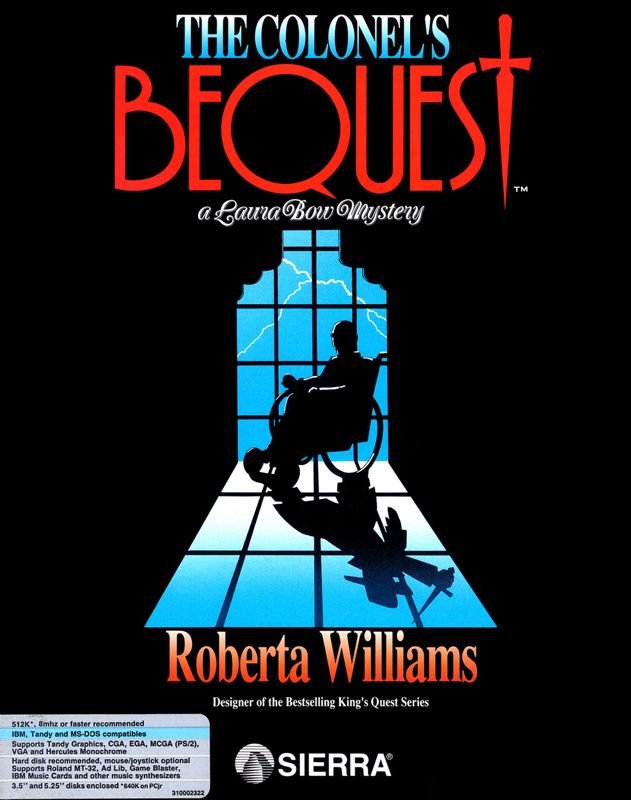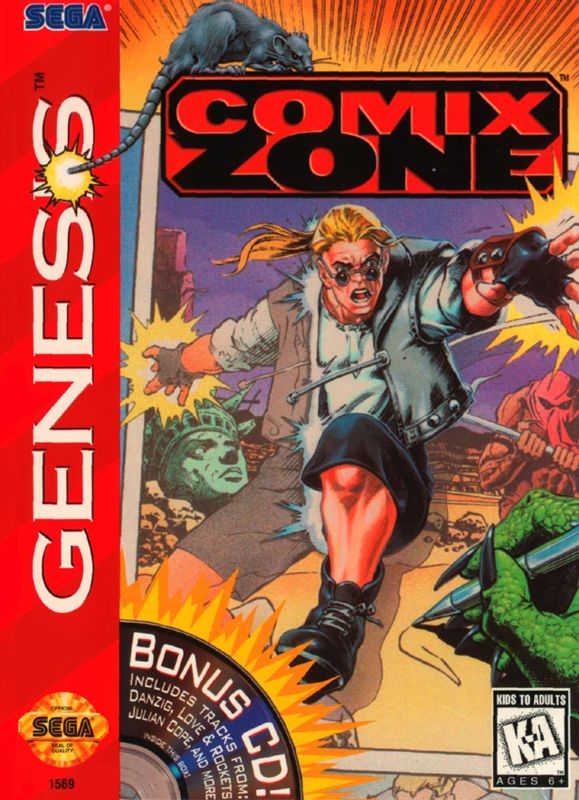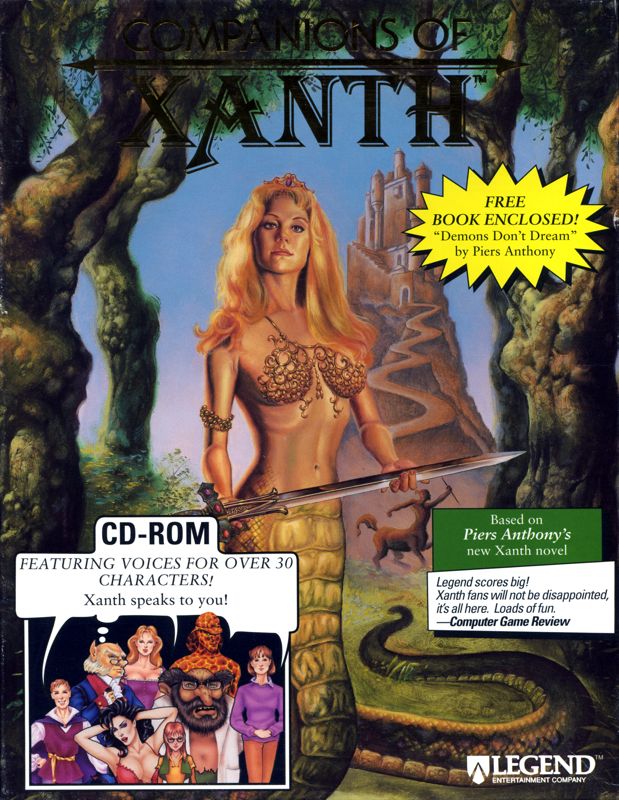the Colonel's Bequest


The year is 1925. Laura Bow is a young student attending the Tulane University in New Orleans, and an aspiring journalist. Her friend Lillian invites her to spend a weekend in a mansion belonging to her uncle, Colonel Henri Dijon, a veteran of Spanish-American war and the owner of a large, but decaying sugar plantation on a secluded island. During the dinner Laura meets members of Lillian's extended family and their alleged friends. As Laura begins to explore the mansion and talk to its inhabitants, she unravels old family feuds and realizes some of those people - if not all - have their own plans and schemes. It all gets much worse when strange accidents and murders start to occur. Laura must investigate those gruesome events and find the culprit.
The Colonel's Bequest is a detective mystery adventure game very similar in style and presentation to Agatha Christie's novels. The game world is confined to the island and consists of numerous interconnected areas, such as various rooms in the mansion, garden, smaller structures, etc. The player is free to explore much of the game's world right from the beginning, with only a few areas being initially inaccessible. The game's clock advances a quarter of an hour each time Laura performs an action pertaining to the plot. Characters have their own schedules and clues are often obtained by discretely observing their actions.
The player interacts with the environment by typing verb-object command combinations (such as "Look Garden", "Talk Colonel", etc.). Some of the most common actions have keyboard shortcuts. The gameplay largely focuses on exploration. Much of the plot stays in the background and can be uncovered by talking to the characters about various topics (mostly other people). There is an inventory and a few puzzles, but they play a much less prominent role in the game compared to other adventures by Sierra. It is possible to complete the game without having discovered the entire plot or even without having identified the murderer. There is no scoring system, but after the game is finished the player is given a detective ranking and told about story branches or other elements he might have missed.
The Colonel's Bequest is a detective mystery adventure game very similar in style and presentation to Agatha Christie's novels. The game world is confined to the island and consists of numerous interconnected areas, such as various rooms in the mansion, garden, smaller structures, etc. The player is free to explore much of the game's world right from the beginning, with only a few areas being initially inaccessible. The game's clock advances a quarter of an hour each time Laura performs an action pertaining to the plot. Characters have their own schedules and clues are often obtained by discretely observing their actions.
The player interacts with the environment by typing verb-object command combinations (such as "Look Garden", "Talk Colonel", etc.). Some of the most common actions have keyboard shortcuts. The gameplay largely focuses on exploration. Much of the plot stays in the background and can be uncovered by talking to the characters about various topics (mostly other people). There is an inventory and a few puzzles, but they play a much less prominent role in the game compared to other adventures by Sierra. It is possible to complete the game without having discovered the entire plot or even without having identified the murderer. There is no scoring system, but after the game is finished the player is given a detective ranking and told about story branches or other elements he might have missed.
Comix Zone


Sketch Turner was a starving comic book artist, living with his pet rat Roadkill... that is until a lightning storm mysteriously brought his cartoon villain, Mortus, to life and imprisoned Sketch within the pages of his own comic book. Now trapped in the world that he himself created, but someone else is now drawing, Sketch must battle through the pages of his own comic book, and past his own creations, to a final battle with Mortus. Perhaps one of his own creations, General Alissa Cyan might be able to help...
Comix Zone is a side-scrolling fighting game with a difference, you're inside of a comic book and you yourself know it. Smash enemies into the sides of frames, rip through the paper to unleash a super move and otherwise wreck havoc throughout the limitations of the graphic novel. Sketch himself can jump, attack and use various items that he finds along the comic book, including his rat friend, Roadkill. Button combinations can be used to unleash powerful techniques.
The game progresses linearly through each page of the comic book, however secret paths and alternate routes through the story can be discovered. At the end of each level, Sketch receives a super hero rating for how well he's progressing.
Comix Zone is a side-scrolling fighting game with a difference, you're inside of a comic book and you yourself know it. Smash enemies into the sides of frames, rip through the paper to unleash a super move and otherwise wreck havoc throughout the limitations of the graphic novel. Sketch himself can jump, attack and use various items that he finds along the comic book, including his rat friend, Roadkill. Button combinations can be used to unleash powerful techniques.
The game progresses linearly through each page of the comic book, however secret paths and alternate routes through the story can be discovered. At the end of each level, Sketch receives a super hero rating for how well he's progressing.
Command H.Q


A one-on-one, real time strategy war game. Conquer the world or fight smaller battles. Choose your time period/scenario (1918, 1942, 1986, 2023, or ????); the later the date the more advanced the game. The 1918 games provide only land and sea units. 1942 adds air units and carriers. 1986 and beyond add nukes, satellites, oil considerations, and foreign aid.
You can create custom layouts (scenarios). Games can also be saved to "film" so you can watch them again. You can even watch the game up to a certain point and then start playing it.
As for opponents, you can play five different levels of computer opponent or a friend on another computer. Two person play requires a modem or serial link.
You can create custom layouts (scenarios). Games can also be saved to "film" so you can watch them again. You can even watch the game up to a certain point and then start playing it.
As for opponents, you can play five different levels of computer opponent or a friend on another computer. Two person play requires a modem or serial link.
Companions of Xanth


Two otherworldly and all-powerful demons are competing with two unwitting human champions over the future of the magical realm of Xanth. One of these unlikely champions is Dug Mundane, a young lad from our world who has just broken up with his girlfriend Pia. His friend Edsel sends him a computer game, betting that if Dug ends up liking it he'll forfeit his attempts to win Pia's heart back. However, when Dug puts the game disk into his computer, he is teleported to Xanth, where his adventures begin.
Companions of Xanth is an adaptation of Piers Anthony's fantasy novel Demons Don't Dream (included in some releases), taking place in his mystical and punny world of Xanth. Unlike Legend's previous parser-based adventures, this one is fully mouse-controlled. Commands such as "take", "give to", "listen", etc. are on the left of the screen; directional icons and an inventory are at the bottom, with an illustration of the current location taking up over half of the screen. The gameplay relies mostly on inventory-based puzzles, with many solutions involving puns.
Besides puzzle-solving, there are also branching conversations with the various characters populating the world. The game is divided into several areas; some are interconnected, while others become unavailable for exploration as the plot advances. It is possible to die in the game, though the player is allowed to undo his last move if that happens. There are also a few instances of getting irrevocably stuck if the player failed to pick up a crucial item in an earlier area. Although the game invites the player to pick up a companion in the beginning, only one choice is correct, while others lead to a premature end of the game. The chosen companion can be talked to most of the time and provides hints and solutions to some puzzles.
Companions of Xanth is an adaptation of Piers Anthony's fantasy novel Demons Don't Dream (included in some releases), taking place in his mystical and punny world of Xanth. Unlike Legend's previous parser-based adventures, this one is fully mouse-controlled. Commands such as "take", "give to", "listen", etc. are on the left of the screen; directional icons and an inventory are at the bottom, with an illustration of the current location taking up over half of the screen. The gameplay relies mostly on inventory-based puzzles, with many solutions involving puns.
Besides puzzle-solving, there are also branching conversations with the various characters populating the world. The game is divided into several areas; some are interconnected, while others become unavailable for exploration as the plot advances. It is possible to die in the game, though the player is allowed to undo his last move if that happens. There are also a few instances of getting irrevocably stuck if the player failed to pick up a crucial item in an earlier area. Although the game invites the player to pick up a companion in the beginning, only one choice is correct, while others lead to a premature end of the game. The chosen companion can be talked to most of the time and provides hints and solutions to some puzzles.
Conan the Cimmerian


Conan the Cimmerian was living happily as a blacksmith with his wife in the village of Irskuld, Cimmeria...until one fateful day. A group of horsemen raided his village...Conan was knocked unconscious, awakening only to find his wife and his friends butchered in the aftermath. Conan discovers architect of the slaughter was a wizard named Thoth Amon, a high priest of Cult of Set. Sword in hand, vengeance aflame, Conan now travels south in the land of Hyborea to the city of Shadizar. Here his journey of vengeance begins...
Conan: The Cimmerian is an action-adventure game with some RPG elements. The game is divided into 3 areas. The first is the overland map, where Conan may travel only between identifiable town and other locations. The second is the town map, here Conan is viewed in a horizontal 3rd Person and the last is the combat screen (or when he enters houses) where Conan is viewed in vertical 3rd Person. Conan may also view his character status and inventory sheet, anytime during the course of the game.
Gameplay consists of exploration and combat. The exploration element in the game sets Conan to find his way around towns and hidden locations, often breaking in houses and searching the premises for hidden loot. Towns consist of various places to visit, among others temples which usually offer quests, shops offering weapons and other items, and inns to stay for a health boost. NPC’s may be conversed with to seek information, while the tougher-looking types may be provoked into combat.
Combat is real-time, one-on-one with Conan on the left and the opponent on the right, consisting of only movement to the left or right and attacking. There are no defensive maneuvers. Both must now keep on attacking until the health bar of either side drops to zero. If Conan wins, he may search the remains and may find loot. At the beginning of the game, Conan may only use one sword style (swing) out of three available sword styles. Additional sword styles may be trained by a sword master.
Conan: The Cimmerian is an action-adventure game with some RPG elements. The game is divided into 3 areas. The first is the overland map, where Conan may travel only between identifiable town and other locations. The second is the town map, here Conan is viewed in a horizontal 3rd Person and the last is the combat screen (or when he enters houses) where Conan is viewed in vertical 3rd Person. Conan may also view his character status and inventory sheet, anytime during the course of the game.
Gameplay consists of exploration and combat. The exploration element in the game sets Conan to find his way around towns and hidden locations, often breaking in houses and searching the premises for hidden loot. Towns consist of various places to visit, among others temples which usually offer quests, shops offering weapons and other items, and inns to stay for a health boost. NPC’s may be conversed with to seek information, while the tougher-looking types may be provoked into combat.
Combat is real-time, one-on-one with Conan on the left and the opponent on the right, consisting of only movement to the left or right and attacking. There are no defensive maneuvers. Both must now keep on attacking until the health bar of either side drops to zero. If Conan wins, he may search the remains and may find loot. At the beginning of the game, Conan may only use one sword style (swing) out of three available sword styles. Additional sword styles may be trained by a sword master.
Tidak ada komentar:
Posting Komentar